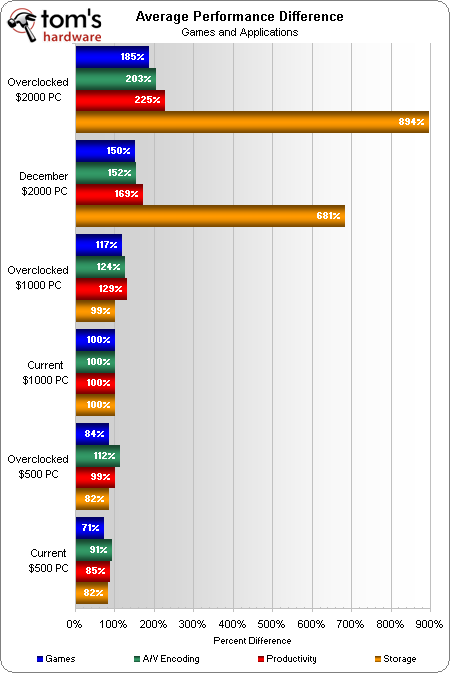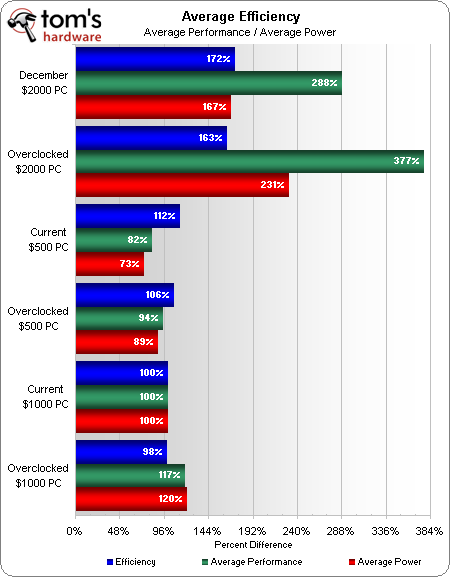System Builder Marathon, December 2010: Value, Compared
New benchmarks, new test methods, and new hardware mark exciting updates to this month’s System Builder Marathon. Today, we cover the most exciting part of all: the value competition. Remember, we're giving all three systems away, so enter to win them!
Power, Performance Scaling, And Efficiency
Power consumption is the one place where a low-cost single-GPU machine usually shines, and today’s $500 build is no exception. Three things that hurt the $2000 machine’s power consumption in comparison to the $1000 PC are its CPU manufactured on a larger lithography process, extra CPU cores, and an old-school GF100-based GPU.
Since most of our benchmarks get zero direct benefit from SSD drives, money spent there was formerly unrealized in our value comparison. Our previous resistance to SSD requests ended with the compromise that drive performance would count towards ¼ of the final results in today’s comparison. Let’s take a look at what that does to our overall performance charts.
Ouch. So large a difference might make today the first time that our high-end machine is fully-competitive with the lowest-cost build in both efficiency and value!
Accounting for only ¼ the overall score, vastly superior hard drive performance roughly doubles the high-end machine’s average performance rating. The result is a giant lead in efficiency, since efficiency is a measure of work per unit of energy. Some of our readers disagree about this being an unfair advantage, since program launch time is a big part of what helps them to define a “high-end” build.
Current page: Power, Performance Scaling, And Efficiency
Prev Page Benchmark Results: Productivity Next Page Value ConclusionGet Tom's Hardware's best news and in-depth reviews, straight to your inbox.
-
wribbs I really enjoy these SBM articles but you need to start putting out these systems/articles faster because by the time you post these configs no one would build them. These "December" systems all use November parts. When you know an important part (CPU/GPU) is going to be replaced by a newer model before the article will post, just wait a few days for it.Reply
That said, SSD is a great addition as well as some of the other difficult to measure in value parts. -
Your 'flexible' statistics are a joke! We'd really like the $2000 system to win to so we'll shovel in the hard drive figures with massive over-emphasis... It's bollocks.Reply
-
Twoboxer I don't understand introducing SSDs into these builds. Buying an SSD is a binary decision: if you want faster load times, you add an SSD . . . if not, you don't.Reply
These builds are targeted at a fixed budget, and (at the moment, with these budgets) money should never be spent on an SSD at the expense of more cpu or graphics power.
Dropping SSDs would also stop convoluting the "value" comparison. -
ethaniel 82% performance at half the cost? 500 USD build for me, thanks. I can add a 100 bucks SSD anytime (and they'll just keep dropping). Newegg has some nice, cheap SSDs out there...Reply -
tapher This has been a very informative triple build review, and this article sums up the lessons nicely! The point about the $1000 PC and games being fine with dual cores was gratifying to see echoed in the summation.Reply
The fact that problems were encountered during the builds, such as the issue with memory, and the issue with the bios; these are important practical lessons that make the articles well worth the time to read.
Overall, I can't imagine a better choice of builds, nor a better outcome, given Sandy Bridge on the horizon. -
jestersage How about timing the marathon differently. It seemas doing it at the end of the quarter isn't such a good idea because of new tech launch schedules this half of the year. Maybe release the article in the middle of every quarter?Reply
In any case, the $500 build rocks my boat. I just feel it isn't right to saddle the $1000 build with a dual core, hyper-threaded or not. An AMD triple/quad core with bad-@ss cooling (at the same price) might have been better. -
Crashman canting_dissentorYour 'flexible' statistics are a joke! We'd really like the $2000 system to win to so we'll shovel in the hard drive figures with massive over-emphasis... It's bollocks.d00d, that's what a bunch of readers wanted. We all know that SSDs waste money for most users, but the site was overwhelmed by readers who claimed they couldn't wait for four seconds on a process that should open in three.Reply




